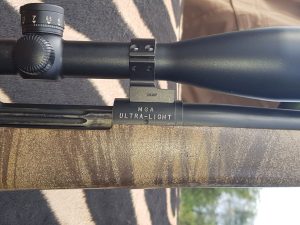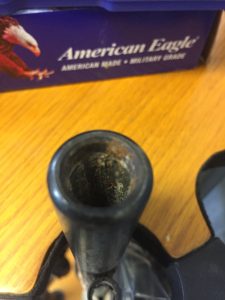By Kerry O’Day
Last year your gun shot great! You were able to make a great 250-yard shot on your best White-Tail buck and killed several pigs. Your rifle was right – an inch high at 100 yards and shot sub-one-inch groups. So this year why is the rifle shooting bad and in a completely different place if you can even shoot a group at all?
Customers bring their rifles in before hunting season every year and want to know why the gun that shot so good last year won’t hold a group this year. Well, there are several simple things that can go wrong to make your rifle not shoot well and there are several major things that can go wrong that cost hundreds of dollars to fix.
Changing ammo can cause your rifle not to shoot the same. With the ammunition shortage, we are having, finding the same .270 caliber 130-grain Barnes ammunition may be impossible. So, you bought some Winchester Fail-Safe 130 grain ammo which may not shoot well in your gun and the point of impact will not be 1 inch high at 100 yards anymore. Ammunition of different types will shoot differently, 130-grain Barnes will not shoot the same as 130-grain Winchester. Different ammunition companies use different types and shaped bullets, some are longer and some with more lead core exposed so the bullet will leave the barrel rifling in a different place making your point of impact different. Different ammunition uses different types of powder and will have a different burning rate which can cause different bullet velocities coming out of your 22-inch barrel. You should try to find the same ammunition that you have always shot if you can. Finding ammunition is hard now, you may have to search and go online and order several months in advance for your hunting trip. Expect to pay way more for your favorite ammunition than you ever have. Shortages have driven prices through the roof. You should expect to pay 3 to 10 dollars a round for good hunting ammo, but as you know, the ammo is the cheapest part of a good hunt.

Loose scope mounts or rings are the number one reason your rifle won’t shoot accurately anymore.
Scopes almost never go bad, but scope bases or rings go bad all the time. The weakest part of a rifle is the scope base. If one screw is loose or broken it will allow the scope to shift and you will never shoot a good group. The Leupold ring and base set is one of the weakest and most problematic bases on the market. The back ring is being held on with a small lip of a screw and as the rifle gets shot it will try to push the scope forward under recoil. The shifting will strip the screw and the scope will come loose. If a gunsmith installs the base and ring correctly, they will hold well but most of the time the rings are just thrown on the base un-centered and the screw will strip. If a shooter will use a good Picatinny rail base with a lock ring it holds much better. Leupold also makes a dual dove-tail base and ring set which is one of the strongest rings made. Most gunsmiths won’t use the dual dove-tail base and ring because they are very hard to get lined up correctly. One more problem is if the screws on the rings holding the scope to the base are not tight enough the scope will slip forward and the point of impact will change with every shot. Rings made from aluminum should be torqued to 15 or 18-inch pounds. Any less torque will let the scope slip forward and too much torque will strip the screw hole. Steel rings can go up to 25-inch pounds, much more than 25-inch pounds can bend or crush the scope tube. We do see scopes go bad. The crosshairs will come loose and jump every time you shoot. Less expensive scopes have springs holding the crosshairs in place, if moved too far with the windage screw it can cause the spring to bend. A scope will have to be sent back to the factory for repair which can take weeks to months.

Leaving your rifle uncleaned for a year can cause the inside of the barrel to rust.
The last main problem is neglect, not cleaning or putting the rifle away last year, and forgetting about it until you want to use it for a hunt. I had a customer bring in one of my custom rifles which I had made for him three years earlier. The gun was an extremely high-velocity caliber which needs to be cleaned every 10 to 20 times you fire it. We spent over an hour cleaning and lapping the barrel to get all the copper fouling out. I don’t think he had ever cleaned the barrel since he bought the rifle. He was lucky, it had a custom stainless barrel on the rifle. If it had been a cheap carbon steel barrel, it would have been ruined. In the last two weeks, I have had four rifles brought into the shop with ruined barrels from not cleaning them after hunting last year. Blue steel guns and fouling don’t mix. When you shoot a rifle, it will get very hot and as it cools moisture will form inside the barrel just like being in a sauna. If the copper and powder fouling is not cleaned, rust will start and keep eating away at the steel until it is cleaned and stopped.
Take the time to clean your rifle after you’re done using it. Keep the screws torqued to 20-inch pounds on the rings so the scope will not slip and use the same ammo that the gun likes, and you will have a good hunting year.
